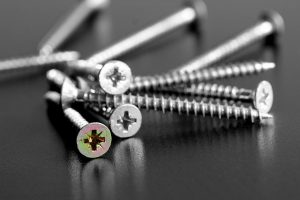
Featuring exterior helical ridges, screws are among the world’s most commonly used fasteners. The exterior ridges, or threading, allow screws to remove material from the object or surface in which they are inserted. As you drive a screw into a wall, for example, some of the excess material will ride up along the ridges to exit the hole. There are many different types of screws, however, one of which is countersunk. So, what is a countersunk screw?
Overview of Countersunk Screws
Also known as a flat-heat screw, a countersunk screw is a type of screw that’s designed to rest flush with the object or surface in which it’s inserted. They are called “countersunk screws” because they “sink” into objects and surfaces. They feature a flat head that tapers along the shaft. Therefore, when you drive a countersunk screw into an object or surface, the head will sink so that it’s flush with the respective material.
Most screws, of course, have a rounded or semi-rounded head. Countersunk screws differ in the sense that they have a flat head. They still have exterior helical ridges. Countersunk screws are simply characterized by their flat head, which allows them to sink into objects and materials.
Why Countersunk Screws Are Used
Countersunk screws are used in a wide variety of fastening applications. You’ll often see countersunk screws used to secure doors to frames, for instance. With traditional screws, the screw head will protrude out. And if you close a door that’s secured with protruding screw heads, it will stress both the door and the frame. Countersunk screws solve this problem by allowing the door to sit flush against the frame. The head of countersunk screws are completely buried, so there’s a smooth and level contact between the door and the frame.
Countersunk screws are also used in many other woodworking and joinery applications. Since the heads sink, they can be concealed with the use of a cap or filler material. After driving a countersunk screw into an object or surface, a worker can cover it with a cap or filler. This isn’t possible with other types of screws since the head will protrude out.
In Conclusion
Countersunk screws are just like all other screws, except they are designed to rest flush with the object or surface in which they are inserted. They feature a flat head with tapered threading that sinks into the material.
